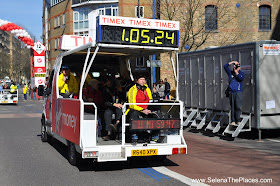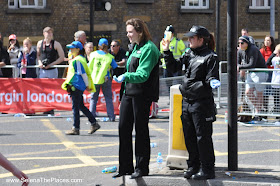Road trips were an annual event when I was young. Whether it was moving to our next base, heading to Tennessee to visit the cousins or a trip to Florida, my brother and I would pile into the car with my parents and hit the road. Eight to ten hours in a car was nothing. Some of my best and craziest memories are road trip shenanigans. (Think the Griswolds in Vacation.) "Are we there yet?" was the mantra of my childhood.
One of the coolest things about road trips in the UK is that they take you to places like France, Belgium and Luxembourg. Over Easter break, Matt and I decided to do just that. I've written before about taking the ferry across the English Channel and we've take the Eurostar to France and Belgium a few times now. This was the first time we took our own car across the Eurotunnel.
The train leaves from Folkestone, England (which is where Matt grew up) and arrives in a village just outside of Calais, France in just over half an hour. We booked our tickets in advance online for a specific time, but they do offer flexible tickets. (When you get to Folkestone, be on the look out to your left for a large white chalk horse in the hillside.)
We arrived in plenty of time and passed from line to line. First we checked in at an electronic kiosk using our reservation information and received a ticket to hang from the rear view mirror with our Boarding Letter displayed. Once you're all checked in, you are directed to the terminal to wait. We parked and went in to relax for a bit.
The terminal is large with a duty-free shop and several fast-food options. There is a departure board to alert you when your assigned letter group is starting to board. (The process coming back was almost identical and there is also a nice terminal on the French side.) Once our letter was displayed it was back to the car and off to France.
Well, not quite yet. Time for more queuing. Getting through all of this and onto the train, takes longer than the actual ride through the channel tunnel. There were times when we turned the engine off and just sat there. It was a busy weekend because of the holiday so I'm not sure if it is always like this.
Eventually, one by one, each car is loaded onto the train. There are two levels and we took a wager on whether we would be top level or lower level. Obviously, the train is open all the way through for loading. But before it departs each compartment is closed off. But there are doors on either side so you can walk along the full length of the train and even go to the other level via the stairs.
There are toilets every few cars, but most of them were out of order that day so after waiting in a line, I had to use a pretty icky toilet without any toilet paper. And there are no extras like a snack bar to get a sandwich or soda. There are several attendants that walk through often if you need assistance with anything.
Then you just sit in your car for the journey. Usually it's pretty quick so the toilet thing shouldn't be an issue. But, there were problems on one of the two lines so we were delayed. Once boarded onto the train we sat there for another hour
before we were able to leave.
One last thing to mention, the train smells strongly of car exhaust obviously. When you add to the equation the fact that you're in a deep tunnel, the air can feel very heavy. I was getting over a chest cold and was feeling pretty uncomfortable. There is always a chance you could be delayed so I'd recommend if you use one, have your inhaler close by. (And also please disregard how filthy our car is. Yikes, it needs a wash.)
Here are some fun facts about the Eurotunnel.
The Channel Tunnel opened in 1994 and
consists of three tunnels, two for trains and one service tunnel which are all connected.
The Channel Tunnel is just over 30 miles long and 24 of those miles are under water.
The Channel Tunnel was built at a cost exceeding £9 billion.
Eleven 15,000 ton tunnel boring machines were used to drill the tunnels at a rate of 15 feet per hour.
The chalk that was excavated from the tunnels by the British was dumped into artificial lagoons behind protective sea walls at the base of the white cliffs of Dover. The resulting 86 acres of land is now a nature reserve called Samphire Hoe.
Once off the train on the French side, we went through passport control while still in our car. The booths are on both sides of the car, so either of you in the front seat may be the one communicating with the guards. With one last reminder to "Please drive on the right as you exit," we were able to continue our road trip in France.
If you plan to drive in France, be sure to check out the Driving in France requirements. There is a great checklist of all of the items that are required to drive legally in France including a Breathalyser, reflective jacket, emergency triangle and a GB sticker. We were able to purchase a kit for about £20 online that contained everything that we needed. There is also a shop at the terminal that sell automotive supplies.
The Channel Tunnel opened in 1994 and
consists of three tunnels, two for trains and one service tunnel which are all connected.
The Channel Tunnel is just over 30 miles long and 24 of those miles are under water.
The Channel Tunnel was built at a cost exceeding £9 billion.
Eleven 15,000 ton tunnel boring machines were used to drill the tunnels at a rate of 15 feet per hour.
The chalk that was excavated from the tunnels by the British was dumped into artificial lagoons behind protective sea walls at the base of the white cliffs of Dover. The resulting 86 acres of land is now a nature reserve called Samphire Hoe.
Once off the train on the French side, we went through passport control while still in our car. The booths are on both sides of the car, so either of you in the front seat may be the one communicating with the guards. With one last reminder to "Please drive on the right as you exit," we were able to continue our road trip in France.
If you plan to drive in France, be sure to check out the Driving in France requirements. There is a great checklist of all of the items that are required to drive legally in France including a Breathalyser, reflective jacket, emergency triangle and a GB sticker. We were able to purchase a kit for about £20 online that contained everything that we needed. There is also a shop at the terminal that sell automotive supplies.
More to come tomorrow.
What is your best road trip memory?
























































